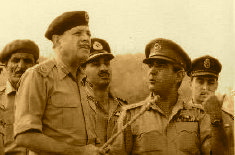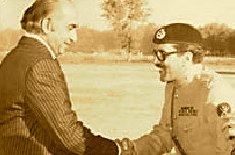Through my researches about the history of Pakistan, I have come upon a rather curious pattern. It is the recurrence of “peak moments” precisely every twentieth year (with one interesting change).
The gathering of Muslim community representatives from all over India at Aligarh in 1886 was the first of its kind in Islam since the days of the early caliphs. Strangely, something similar has been happening since then – every twentieth year with a slight change in 1947:
1886, Foundation of Muslim Educational Conference
1906, Foundation of All-India Muslim League
1926, General Elections on the basis of separate electorates
1946, General Elections on the question of Pakistan
1967, Birth of PPP and popularity of 6 Points
1987, General discontent with General Zia
2007, Lawyers’ Movement
Why does it happen, and can it help us in a better understanding of our history (and of ourselves)?
That question can be answered in several ways depending on how you approach it. Yet, in whatever way these “peak moments†are interpreted, they help us divide the history of Pakistan since 1886 into seven symmetrical periods:
1886-1905, Inquiry
1906-1925, Discovery
1926-1946, Transcendence
1947-1966, Freedom
1967-1986, Action
1987-2006, Expansion
2007-26, Creation
The names of the stages (i.e. inquiry, discovery, and so on) have been taken from the “Seven Stages” which recur in Iqbal’s work as I’ve shown in my book The Republic of Rumi: A Novel of Reality (2007) and discussed briefly in my online newsletter. Needless to say, those who may like to name these periods differently can do so (“What’s there in a name…”)!
The beauty of dividing history into these seven periods is that not only this division is symmetrical but it is based on the peak moments of the entire society rather than the coming and going of individual rulers. Does this sound better than naming the periods of our history “the Ayub Khan era”, “the Yahya Khan era,” and so on? To me, it does.
There are other uses. Patterns naturally lead to the possibility of forecasting. Once we observe certain patterns in the history of Pakistan we are likely to recognize the possibility of forecasting the future of this nation. In order to test my observations since I first came upon them in the summer of 2007, I have been making forecasts: about the results of Elections 2008, for instance. Such forecasts have turned out to be correct.
Yet, quite understandably, I have faced so much hostility from some “friends and foes†on this issue that I think I should now withhold my interpretations until I get the opportunity of displaying the background reading involved in the matter (for now, it may suffice to say that Muhammad Ali Jauhar, who had a degree in history from Oxford, was also working along these lines but unfortunately there had been only two peak moments by then, and hence not enough data to proceed with the investigations).
The beauty of this twenty-year division is such that I don’t want to spoil it even for a skeptic: in my zeal for saying more, I don’t want to put off any who might be more sympathetic to it if I left it at this but whose minds may get shut off if I said more!





















































Lutf ul Islam
Very well described. It’s a scary thought but I think we are in this mess for a long haul.
One thing is guaranteed that we can’t get rid of Mullahs, so why don’t we learn to live with them and accept them. In long run some moderate Mullahs will emerge from them. Right now when we try to suppress them even ridicule them, we give rise to more extreme views and violence.
Will banning them from politics work?
My above comments about Mullahs do not include extremist Jehadi groups. We can’t accept them, let alone live with them.
Riaz:
If you’re talking about military take overs, then we are used to 11 year cycles.
The pre-Ayub political period: 11 years from 1947 to 1958.
Ayub’s period: 11 years from 1958 to 1969.
Zia: the famous 11 years
Post-Zia civilian period: again 11 years from 1988 to 1999.
The Yahya period was only about 2 years but Musharraf was there for about 9 years, so the total is, again 11 years.
Bhutto didn’t complete 11 years since he shot himself in the foot sooner, and he was there for about 5 and a half years.
If the 11 year trend is to continue, then the next military coup should probably be around september 2013. This, along with Bhutto’s 5 and a half years will complete another 11 years of civilian rule.
Cycles theories are quite popular in business and investment world. I guess we could try and develop similar theories about Pakistan. How about an approx 10 year cycle (every other decade) for military takeovers? Ayub in the 60s, Zia in the 80s, Musharraf in the 00s? The way things are going right now, these cycles could shorten with the military intervening sooner this time, with people demanding and welcoming the military takeover, as in the past.
Interesting.
Perhaps your 20 year pattern will match the lunar calendar more accurately?
Until the creation of Pakistan, the trend had been upwards (higher peaks followed by even higher peaks) but since then we have just been sliding down. Every few years, a small peak emerges to temporarily halt the downward slide. Like any other artificial trend it does not last very long and hence we continue down the roller coaster. One thing I have noticed is that the peaks are small and few. Like NASDAQ